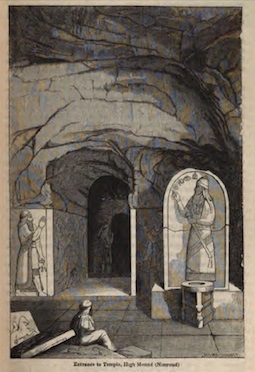Anzu the monstrous lion-eagle
The Anzu bird, half-lion, half-eagle, had been a mainstay of cuneiform TT culture from at least the third millennium BC. He appears in Sumerian literary works as a wild creature of the mountains. He can also be tamed by the gods, as depicted in monumental sculpture. In 9th-century Kalhu, he was portrayed doing battle with the warrior god Ninurta, at an entrance to the most important shrine of the royal citadel TT . Layard PGP discovered this sculpture in the mid-19th century, and shipped it to the British Museum TT . For generations this unnamed "dragon" or "demon" TT captivated the public imagination in many different ways. However, it took over half a century to rediscover Anzu's true identity.
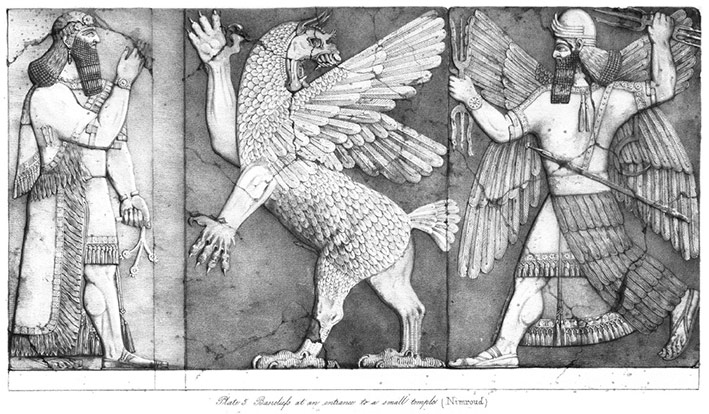
Image 1: In Layard's PGP glossy publication of sculptures from Nimrud and Nineveh PGP he simply labelled the relief TT later known as Anzu and Ninurta as "Bas-reliefs from the entrance to a small temple (Nimroud)" (1). The engraving was made by the eminent Ludwig Gruner PGP . View large version (277 KB).
Fight or flight: Anzu in Ninurta's temple
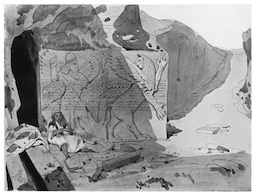
Image 2: Solomon Malan PGP 's sketch, made on the spot at Nimrud in 1950, shows the northern member of the pair of bas-reliefs TT coming out of the ground (2). The southern one, which originally stood opposite, has already been removed. The tunnel to the left shows how Layard's men dug by following the temple walls. View large version (236 KB).
There were two ways into the shrine of the mighty god Ninurta, nestled into the southeast corner of the ziggurat at Kalhu. The most direct entrance was flanked by enormous stone human-headed lions. When the doors between them were opened, priests and the privileged few could gaze directly through an ante-chamber to the statue of the deity himself (Room A on the plan). Alternatively, they could enter and exit through a doorway just to the north of the lion gateway, and then turn back south into the antechamber or the shrine (Room B). Protective male figures holding branches were positioned on the courtyard side of the doorway, fish-cloaked figures on the interior side. A huge sculpture of king Assurnasirpal PGP stood just to the right.
The doorway to Room B was lined on both sides with mirror-image depictions of the same extraordinary scene (Image 1). A towering male figure in a long robe bears down on a monstrous creature, half lion and half eagle, who turns back to him open mouthed, claws out. The bearded man's horned helmet and double wings mark him out as a god. His muscles bulge and he is laden with weapons. A sickle TT and a sheathed sword hang from his body, while he clutches forked bolts of lightning in each hand. This can only be the culminating episode in The Epic of Anzu, where Ninurta cunningly defeats this demonic TT force of chaos, and reclaims the Tablet of Destinies TT for the gods.
The image of Ninurta chasing Anzu out of his temple powerfully marries the militaristic ideals of Assyrian kingship with the importance of scholarly learning. One the one hand, Ninurta must use intelligence as well as brute force to defeat the wicked Anzu. On the other, his quest is to recover the Tablet of Destinies, which records the gods' decisions about Assyria's future. Court scholars advised the Assyrian king on his military decision-making by interrogating the gods about their intentions, through various forms of divination TT . Assyria went to war only with the gods' blessing, and with victory assured in the Tablet of Destinies. Assyrian royal inscriptions increasingly acknowledged the role of scholarly divination in predicting divine support and garnering military success.
Assurnasirpal II commissioned the building of Ninurta's shrine early in the ninth century BC. When the royal court moved to Dur-Šarruken PGP , and then to Nineveh PGP , in the late eighth and early seventh centuries BC, Ninurta was already losing royal patronage in favour of Nabu PGP . Now that the empire had stabilised, learnedness was more fashionable than militarism. Nevertheless, Ninurta's temple survived nearly 200 years of royal neglect, and the twin monuments to his victory over Anzu remained standing, right until Kalhu's temples were pillaged by invaders at the end of empire in 612 BC (4).
A monster unearthed: but which one?
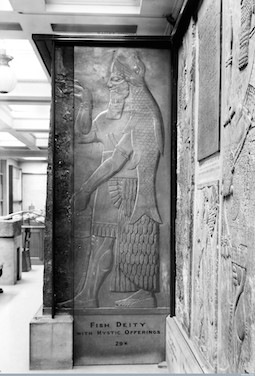
Image 4: Well into the 20th century, the British Museum's Nimroud Gallery displayed Ninurta and Anzu as Marduk PGP and Tiamat, adjacent to a restoration of the fish-cloaked figure that had stood with it in the temple. Look closely and you will spot that it doubles as a cupboard door! Source: M0007475, Wellcome Library, London. CC BY 4.0. View large image.
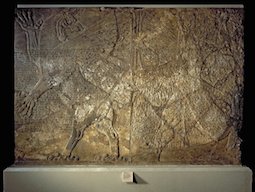
Image 5: These days Anzu and Ninurta may be visited in Room 6 on the ground floor of the British Museum. They are still accompanied by their protective genie TT and the fish-cloaked figure [http://www.britishmuseum.org/research/collection_online/collection_object_details.aspx?objectId=365970&partId=1] from the northern half of the doorway. British Museum ME 124571. View the British Museum's catalogue entry for this object.
Anzu came to light again only in June 1850. A visitor to Layard's excavations at Nimrud, the Reverend Solomon Malan PGP , vividly sketched the northern half of the pair of bas-reliefs, still in its earthen matrix and surrounded by discarded rubble (Image 2). A weary local workman sits propped up in its shade (5). Malan's watercolour is the only surviving record of this object, as Layard decided to keep only the southern member of the pair (Image 3).
The sculpture arrived at the British Museum, as part of much larger shipment of Nimrud artefacts, in 1851. It was set up in the so-called Nimroud Gallery on the ground floor, in between the bas-reliefs of protective genies that had flanked it in antiquity (Image 4, Image 5). But who these two powerful, well-matched figures were, no-one yet knew. The inscription running across the front was very badly worn, and the one on the back could not yet be deciphered. In his account of the excavations, Layard rightly inferred that the image "appears to represent the bad spirit driven out by a good deity; a fit subject for the entrance of a temple dedicated to the god of war" (6). That was as much as anyone could say for now.
Gradually over the next few decades, cuneiform script began to make more sense. In 1876, a full quarter of a century after the arrival of the sculpture at the British Museum, the first clues as to Anzu's identity began to appear. Museum assistant George Smith PGP published a book of translated Assyrian and Babylonian PGP myths that aimed to relate this still difficult material to the much more familiar world of the Old Testament (7). The climax of the so-called "Chaldean account of Genesis" (now better known as the Standard Babylonian TT Epic of Creation TT , or Enūma Eliš) featured a cosmic battle very like that shown in the bas-relief from Nimrud. The warrior god Bel PGP or Merodach — now known as Marduk PGP — defeats the dragon Tiamat PGP with a sword and bow.
Smith confidently identified the hitherto mysterious monument from Nimrud as the "fight between Merodach (Bel) and the Dragon" (8) and even used it on the front cover of the book. He undoubtedly knew that Tiamat was female: "Tiamat opened her mouth to swallow him", he translated (9). Yet Anzu's snake-headed penis was clearly visible in the line drawing he used in the book, though was removed for the sake of Victorian modesty on the cover itself. At almost exactly the same time, Assyriological TT dilettante Henry Fox Talbot PGP made almost exactly the same argument, explicitly bringing the apocryphal Old Testament book "Bel and the Dragon" into the argument (10) (11).
It was to be several more decades before the three monsters — Anzu, Tiamat, and Marduk's mušhuššu-dragon — were disentangled. Meanwhile, the British Museum's curators started to label the Nimrud scuplture as "the conflict between the god Marduk or Bêl and the monster Tiâmat", and continued to do so until at least 1908 (12).
From Zu to Anzu
It did not take long to decipher the inscriptions on the slabs from the temple, establishing it as property of the god "Ninib". British Museum Assyriologist TT Leonard King PGP published the first systematic translation of the temple texts in 1902 (14) (15). W F Albright correctly read the name "Ninib" as Ninurta in 1915 (16). However, there was nothing in these inscriptions to identify the protagonists of the battle scene as Ninurta and Anzu. That was a long time coming.
Another of the narratives in Smith's anthology was the very fragmentary work that he named "The Sin of the God Zu" (17). At that point, in 1876, it was very hard to interpret its contents, except that "Zu" ran away after committing some crime against the gods, who then discussed how to react. As Smith noted, other inscriptions suggested that Zu "was in the likeness of a bird of prey" (18). Gradually, as more pieces of clay tablets TT were discovered, the composition we now call The Epic of Anzu began to take shape. But the process was very gradual indeed. In the late 1940s the Manchester Assyriologist Thomas Fish was still struggling with what the "Zu bird" must have looked like, and which god had defeated him, Marduk or Ninurta (19).
The monster's identity as "Anzu" rather than "the god Zu" gradually gained acceptance over the 1960s and 70s, as it became clear that the first cuneiform sign of the name must be the syllable an and not the (visually identical) divine marker DINGIR (20) (21). Ilse Fuhr-Jaeppelt's diachronic TT analysis of Anzu's iconography TT over the third to first millennium BC, together with Blahoslav Hruška's study and full critical edition of The Epic of Anzu finally put Anzu's identity beyond doubt, a full 125 years after he emerged from the earth of Nimrud (22) (23). In the meantime, however, Anzu's image had taken on a life of its own, far beyond the confines of Assyriology.
Anzu in advertising
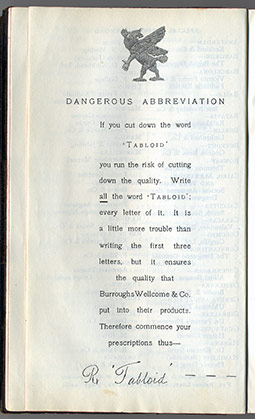
Image 7: Anzu starring in a pharmaceuticals advert in Wellcome's Medical Diary and Visting List (1915). In the early twentieth century, pharmaceuticals firm Burroughs Wellcome and Company distributed around 35,000 of these pocket-sized diaries annually to doctors as a marketing tool. Source: private collection. The Nimrud Project CC-BY-SA 3.0 View large image (763 KB).
In the early twentieth century, Anzu featured in an advert by pharmaceuticals firm Burroughs Wellcome & Company (BW&C) designed to defend its brands of medicines against commercial rivals (Image 7). Headed by businessman Henry Wellcome, BW&C secured financial success in the early twentieth century by selling compressed forms of foodstuffs and medicines, trade-marked under the brand-name 'Tabloid' (but which are now better known as tablets). The company fiercely pursued any copyright infringement, through advertising campaigns and by threatening perpetrators with legal action (24) (25).
As part of their brand protection campaign, BW&C targeted chemists and druggists who passed off cheap home-made medicines as BW&C branded versions, pocketing the profits. The company fought a decade of trade warfare with retail chemists over issues of drug substitution around 1900. (26). They pitched adverts to doctors warning them of the dangers of imitation medicines, and the Anzu advert is once such example. Its sharp wording pushed doctors to write out BW&C trade-marked names in their prescriptions, which forced chemists to dispense branded medicines and not cheaper substitutes. According to BW&C's advert, abbreviating the 'Tabloid' brand-name was actively "dangerous" (Image 7), as it let unscrupulous chemists use dubious ingredients and endanger patients.
The Anzu advert appears in the 1915 edition of Wellcome's Medical Diary and Visiting List, a promotional tool distributed free to doctors (27). These appointments diaries came complete with reference information, a handy pencil, and copious BW&C advertisements. Each diary between 1906 and 1940 featured a different ancient civilisation, catering to a rising interest in history of medicine among the medical profession, and the 1915 diary was entirely Assyrian themed. A complete set of the diaries is now held in the Wellcome Library in London.
Tablet stealers
But why use an image of Anzu to represent cut-throat commercial practices? BW&C likely understood that its well-educated audience of doctors would be familiar with the ancient mythologies depicted in their diaries. Each year they chose an appropriate mythological character to accompany their 'Dangerous Abbreviation' advert, assembling a motley crew of 'baddies' to symbolize commercial evil. Anzu's appearance in 1915 was preceded by the fearsome Gorgon Medusa from ancient Greek legend (1911), whose stare turned men to stone, and the Maori marakihau (1910), a deep-water monster that devoured passing sailors (28) (29) (30).
Some of these characters were famously recognisable, others playfully obscure. And if the company was inviting medical doctors to play 'guess the monster', Anzu was likely one of the more familiar creatures, even if his name was not yet known. His image was famous from Layard's and Smith's books where he was known to represent dark malevolence, even though his exact identity as a bird-monster or dragon was uncertain. The pharmaceuticals company played on this familiarity, visualizing brand infringement practices as an evil creature that needed vanquishing.
Doctors who were familiar with the Assyrian battle scene image may also have noticed what was missing in in the BW&C version: the force of good - the vanquishing hero. In the absence of the champion, was the audience invited to infer that the hero was company proprietor, Henry Wellcome, himself? Certainly, the implication was that in the fight between good and evil, BW&C was the force of good. And Anzu, originally stealer of the Tablet of Destinies, now represented 'tablet stealers' of a pharmaceutical kind.
18 Dec 2019References
- Layard, A.H., 1849-1853. The Monuments of Nineveh: From Drawings Made on the Spot, vols. I–II, London: John Murray (free online edition of vol. 1 and vol. 2), pp. vol II, plate 5. (Find in text ^)
- Gadd, C.J., 1938. "A visiting artist at Nineveh in 1850", Iraq 5, pp. 118-122 and plates XI-XX (PDF available via JSTOR for subscribers), pp. plate XV. (Find in text ^)
- Layard, A.H., 1853. Discoveries in the Ruins of Nineveh and Babylon, London: John Murray (free online edition via The Internet Archive), p. 302. (Find in text ^)
- Reade, J.E., 2002. "The ziggurrat and temples of Nimrud", Iraq 64, pp. 135-216 (PDF available via JSTOR for subscribers), p. 201. (Find in text ^)
- Gadd, C.J., 1938. "A visiting artist at Nineveh in 1850", Iraq 5, pp. 118-122 and plates XI-XX (PDF available via JSTOR for subscribers), pp. pl. XV. (Find in text ^)
- Layard, A.H., 1853. Discoveries in the Ruins of Nineveh and Babylon, London: John Murray (free online edition via The Internet Archive), p. 301. (Find in text ^)
- Smith, G., 1876. The Chaldean Account of Genesis, London: Low, Marston, Searle and Rivington (free online edition at The Internet Archive). (Find in text ^)
- Smith, G., 1876. The Chaldean Account of Genesis, London: Low, Marston, Searle and Rivington (free online edition at The Internet Archive), p. 62. (Find in text ^)
- Smith, G., 1876. The Chaldean Account of Genesis, London: Low, Marston, Searle and Rivington (free online edition at The Internet Archive), p. 98. (Find in text ^)
- Talbot, W.H.F, 1876. "The fight between Bel and the Dragon, and the flaming sword which turned every which way", Transactions of the Society of Biblical Archaeology 5: 1-21. (Find in text ^)
- Robson, E., 2013. "Bel and the dragons: deciphering cuneiform after decipherment", in M. Brusius, K. Dean and C. Ramalingam (eds.), William Henry Fox Talbot: Beyond Photography, New Haven: Yale University Press, pp. 193-218. (Find in text ^)
- British Museum, 1908. A Guide to the Babylonian and Assyrian Antiquities, 2nd edition, revised and enlarged. London: printed by order of the Trustees, p. 24. (Find in text ^)
- Smith, G., 1876. The Chaldean Account of Genesis, London: Low, Marston, Searle and Rivington (free online edition at The Internet Archive). (Find in text ^)
- Budge, E.A.W. and L.W. King, 1902. Annals of the Kings of Assyria: The Cuneiform Text with Translations, Transliterations, etc. from the Original Documents in the British Museum, Vol. 1, London: printed by order of the Trustees, pp. . (Find in text ^)
- Grayson, A.K., 1996. Assyrian Rulers of the Early First Millennium BC II (858-745 BC) (Royal Inscriptions of Mesopotamia. Assyrian Periods. Volume 3), Toronto: University of Toronto Press, pp. nos.A.0.101.3, 5-7, 31. (Find in text ^)
- Albright, W.F., 1915. "Ninib-Ninurta", Journal of the American Oriental Society 38: 197-201 (PDF available via JSTOR for subscribers). (Find in text ^)
- Smith, G., 1876. The Chaldean Account of Genesis, London: Low, Marston, Searle and Rivington (free online edition at The Internet Archive), pp. 113-122. (Find in text ^)
- Smith, G., 1876. The Chaldean Account of Genesis, London: Low, Marston, Searle and Rivington (free online edition at The Internet Archive), p. 119. (Find in text ^)
- Fish, T., 1948. "The Zu bird", Bulletin of the John Rylands Library 31: 162-171. (Free PDF available via University of Manchester Library). (Find in text ^)
- Landsberger, B., 1961. "Einige unerkannt gebliebene oder verkannte Nomina des Akkadischen," Wiener Zeitschrift für die Kunde des Morgenlandes 57: 1-23. (Find in text ^)
- Civil, M., 1972. "The Anzu-bird and scribal whimsies", Journal of the American Oriental Society 92: 271 (PDF available via JSTOR for subscribers). (Find in text ^)
- Fuhr-Jaeppelt, I., 1972. Materialien zur Ikonographie des Löwenadlers Anzu-Imdugud. Munich. (Find in text ^)
- Hruška, B., 1975. Der Mythenadler Anzu in Literatur und Vorstellung des alten Mesopotamien, Budapest: Eötvös-Lorand University. (Find in text ^)
- Larson, F., 2009. An Infinity of Things. How Sir Henry Wellcome Collected the World, London, New York, Toronto: Oxford University Press, pp. 12-13. (Find in text ^)
- Church, R., and E. M. Tansey (2007). Burroughs Wellcome & Co. Knowledge, Trust, Profit and the Transformation of the British Pharmaceutical Industry 1880-1940. Lancaster: Crucible Books, pp. 131–139, 284–285. (Find in text ^)
- Church, R., and E. M. Tansey (2007). Burroughs Wellcome & Co. Knowledge, Trust, Profit and the Transformation of the British Pharmaceutical Industry 1880-1940. Lancaster: Crucible Books, pp. 130-145. (Find in text ^)
- Wellcome's Medical Diary and Visiting List (1915). London: Burroughs Wellcome & Co., WF/M/PB/003/28, Wellcome Foundation Archives, Wellcome Library, London. (Find in text ^)
- Wellcome's Medical Diary and Visiting List (1911). London: Burroughs Wellcome & Co., WF/M/PB/003/24, Wellcome Foundation Archives, Wellcome Library, London. (Find in text ^)
- Wellcome's Medical Diary and Visiting List (1910). London: Burroughs Wellcome & Co., WF/M/PB/003/23, Wellcome Foundation Archives, Wellcome Library, London. (Find in text ^)
- Horry, R. A., 2013. "Transitions and Transformations in Assyriology, c.1880-1913: Artefacts, Academics and Museums", PhD dissertation, University of Cambridge, pp. 96-100, 110-113. (Find in text ^)
Ruth A. Horry & Eleanor Robson
Ruth A. Horry & Eleanor Robson, 'Anzu the monstrous lion-eagle', Nimrud: Materialities of Assyrian Knowledge Production, The Nimrud Project at Oracc.org, 2019 [http://oracc.museum.upenn.edu/nimrud/livesofobjects/anzu/]
